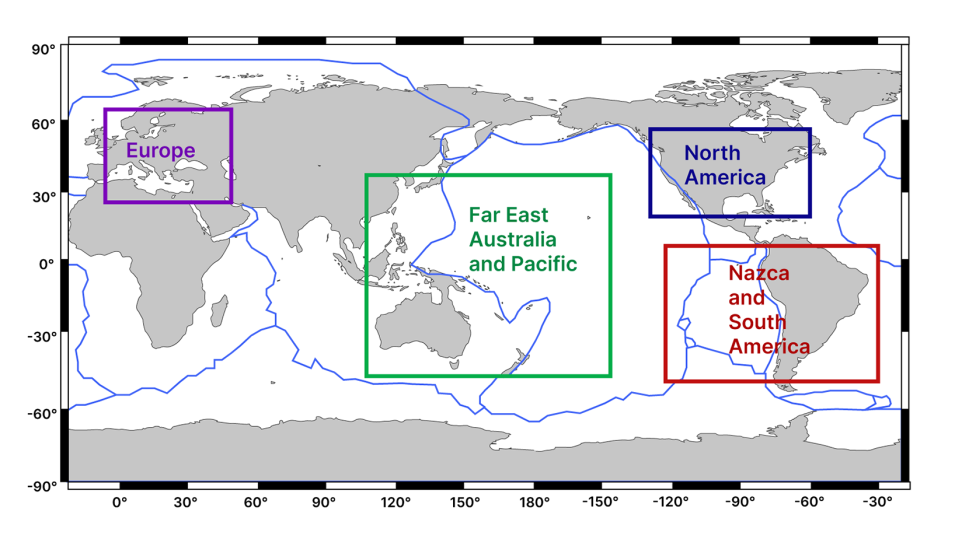With more 15 years of laser tracking data acquired by a network of globally distributed sites, variations in site positions can be monitored through time using Satellite Laser Ranging (SLR). The motions of Earth's plates are largely slow and smooth, with the exception of regions where earthquake activity is high. In earthquake-prone regions, significant surface displacements over a very short time period can and do occur. The results you find here only represent the generally slow and smooth nature of tectonic motion; displacements directly attributable to earthquakes may not be evident in these results.
SLR Tectonic Maps
Above is an index map for the regions of the world for which there are SLR site motion results. For a variety of socioeconomic and political reasons, the entire world is not uniformly covered by SLR observatories. Learn more about Very Long Baseline Interferometry (VLBI) and Global Positioning Systems (GPS) — a type of Global Navigation Satellite System (GNSS) — to discover the parts of the world covered by those technologies.
View SLR estimates of site motions for locations within the following regions:
About the Maps
What software was used to make the maps?
The maps were produced using a software package called Generic Mapping Tools (GMT) written by Paul Wessel and Walter Smith. This mapping package is described in their announcement "Free Software Helps Map and Display Data," published in Eos Transactions American Geophysical Union in 1991. The GMT program can be downloaded from the GMT website. We used the GMT software on a Hewlett Packard 735 workstation. The output of running GMT is a postscript file. This was converted into GIF form using one of the commands supported by a graphics conversion program called Image Magick. The GIF was exported to an Apple Macintosh computer, where it was converted to Macintosh specific PICT format using software called Graphic Converter. Once the image was in PICT format, MacDraw Pro was used to add enhancements such station names and scale bars. After modifications, the file was saved as a PICT file and reconverted to GIF for use in these pages.
What topographic database was used?
The topographic and bathymetric data used came from the 5 minute by 5 minute dataset called TerrainBase. It is a global dataset which for most of the world gives fairly reliable relief features. Note, however, that unusual square or rectangular "plateaus" exist in this dataset, which are clearly in error. For example, in the lower right hand corner of the map of Europe, this type of feature is visible in Saudi Arabia. The TerrainBase dataset can be purchased from the National Geophysical Data Center.
Learn More About Space Geodesy
The yearly NASA Goddard Space Flight Center SLR submissions to the International Earth Rotation and References Systems Service (IERS) are available at NASA's Crustal Dynamics Data Information System (CDDIS) through either https or ftps. Learn more information about the Space Geodesy Project at NASA Goddard. More information on the terrestrial reference frame can be found on the IERS and International Terrestrial Reference Frame (ITRF) websites.
Acknowledgment
The authors would like to acknowledge the contributions of our colleague John Robbins in the original implementation of this information on the web.
